Adaptive Control of Virtualized Resources in Utility Computing Environments - PowerPoint PPT Presentation
1 / 38
Title:
Adaptive Control of Virtualized Resources in Utility Computing Environments
Description:
Solution: Arbiter controller enforcing QoS differentiation. UtilControl for WS I ... Arbiter controller features. Is an integral controller ... – PowerPoint PPT presentation
Number of Views:93
Avg rating:3.0/5.0
Title: Adaptive Control of Virtualized Resources in Utility Computing Environments
1
Adaptive Control of Virtualized Resources in
Utility Computing Environments
Pradeep Padala, Kang G. Shin University of
Michigan
- HP Labs Xiaoyun Zhu, Mustafa Uysal, Zhikui Wang,
Sharad Singhal - University of Waterloo Kenneth Salem
2
A typical scenario in data centers
Customer A
Customer B
Run auction site
Run news site
Shared Data Center
3
Hosting applications
Data Center
Common idiom One-to-one mapping of applications
to nodes
4
Problem Poor utilization
Wasted Resources
Ad-hoc resource allocation schemes waste resources
5
Solution Virtual data center
Web server
Linux
Virtualization (Xen, OpenVZ, VMware)
Consolidate
Improved utilization using consolidation
6
Problem Provisioning
Wasted Resources
Bursty Load
Bad response time
Peak
Average
Provisioning for dynamic workloads is hard!
Solution Adaptive controller
7
Goals
- Good utilization
- Good performance
- QoS differentiation
Average CPU utilization 80
Average response time 100ms
Gold vs. Silver customers 21 resources
8
Outline
- Motivation
- Background
- Modeling
- Design
- Evaluation
- Conclusion
9
How do we provision the customers ?
Customer A
Auction Client
News Client
Virtualized Server I
Virtualized Server II
Customer B
10
What are we controlling ?
- Goals
- Good performance
- Good utilization
- QoS differentiation
VM I
50
80
Goals met ? NO
50
20
VM II
Policy
Mechanism
CPU Usage ?
Controller
Xen scheduler
Set CPU shares
Virtualized Server
11
Related work
- Existing research
- Cluster management
- Load balancing
- Resource allocation scheduling
- QoS differentiation
- Our contribution Adaptive resource control
- Quantitative model of system behavior
- Fine-grained, adaptive control
- No wastage of resources
- High throughput, low response time
- QoS differentiation
12
How do we design an adaptive resource controller?
Understand system variables Input
Output
Design controller PI, PID, I controller
Stress the controller
Goals met ?
A control theoretic approach to systems
13
Outline
- Motivation
- Background
- Modeling
- Design
- Evaluation
- Conclusion
14
Modeling a virtual data center
VM utilization
VM Shares
Throughput
Response time
Workload
QoS differentiation
Virtualized Server I
Virtualized Server II
How to differentiate between two multi-tiered
systems ?
15
Modeling two multi-tiered systemsQoS metric
Linear
Non-Linear
Response time ratio is more controllable than
loss ratio
16
Outline
- Motivation
- Background
- Modeling
- Design
- Evaluation
- Conclusion
17
Utilization controller an example
Controller
Utilization goal 80
Using 20
New Utilization 20/25100 80
Utilization 20/40100 50
- Problems
- Utilization is variable
- Delays and errors in sensing setting
- Stability concerns
Solution Self-tuning integral controller
18
Utilization controller
Workload
Error in utilization e(k-1)
Self-tuning controller
System
CPU allocation u(k)
Utilization goal
Measured utilization u(k-1)
-
- Adjusts to varying demand
- Maintains goal utilization
- Knobs to control aggression (Kp)
- Proven stable Wang DSOM05
19
Let there be controllers
110 Cant fit (Saturation)
Want 40
Want 70
Virtualized Server I
Container consumptions
Problem All controllers independent
Solution Arbiter controller enforcing QoS
differentiation
Virtualized Server II
20
Final controller
Requested CPU shares
Final CPU shares
Arbiter Controller
Virtualized Server I
Container consumptions
Desired response time ratio
Virtualized Server II
21
Outline
- Motivation
- Background
- Modeling
- Design
- Evaluation
- Conclusion
22
Evaluation
- Multi-tiered systems
- 2 HP Proliant servers
- Apache MySQL
- Xen 3.0 with SEDF scheduler
- Clients
- RUBiS auction client
- 2 RUBiS clients 500 1000 threads
- Can we maintain 70 QoS ratio ?
23
Varying load - throughput
1000 threads
500 threads
24
Varying load - control
Saturation
Buffer to maintain good performance
Penalized to maintain QoS ratio
25
Varying load QoS ratio
Goal
Goal ratio of 70 maintained!
26
Conclusion
- Adaptive control of virtual data center
- Good application performance
- High throughput
- Low response time
- Good utilization
- Maintain goal CPU utilization
- QoS differentiation
- Maintain goal QoS ratio
- Project page http//kabru.eecs.umich.edu/twiki/bi
n/view/Main/DynamicControl - E-mail ppadala_at_eecs.umich.edu
- Questions ?
27
Backup and old slides
28
Enterprise data centers
- Large data centers
- 100s/1000s of nodes
- Shared infrastructure
- Run critical applications
- Should meet service levels
- Problems
- Power costs
- Management costs
- Poor utilization
- Unmet service levels
29
Solution Consolidate !
30
Hosting two multi-tiered systems
Auction Client
Customer A
News Client
Virtualized Server II
Virtualized Server I
Customer B
31
Varying load
1000 clients
500 clients
Workload I
Workload II
Time
32
(No Transcript)
33
(No Transcript)
34
Modeling results - throughput
Dom0 effect
Web share
Throughput
Saturation causes Real throughput lt Offered
throughput
35
Arbiter controller features
- Is an integral controller
- Decides final shares based on QoS differentiation
goals - Integral gain knobs for aggression
- Stable gain value based on model
36
Modeling a multi-tiered system
Workload
Web usage
Web share
DB usage
DB share
QoS metrics
Virtual Server
- Stress the system in various scenarios
- Observe all variables
37
Modeling results response time
Dom0 effect
Web share
Response time
38
Questions
- ?































![The Gridbus Toolkit for Service-Oriented [Cluster/Grid] Computing PowerPoint PPT Presentation](https://s3.amazonaws.com/images.powershow.com/P1246211285tuLYR.th0.jpg?_=19691231070)